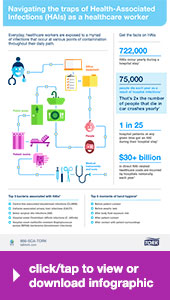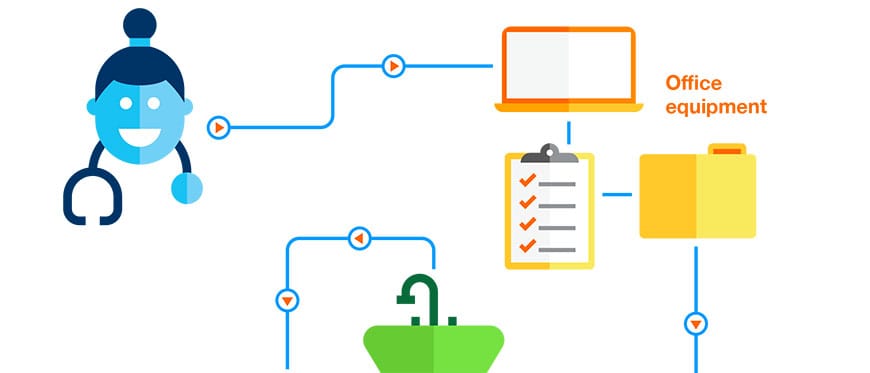75,000 people die each year as a result of health-associated infections (HAIs)1. That’s double number of people that die in car crashes every year2. According to a California Department of Public Health study, 722,000 HAIs occur yearly during a hospital stay1. Across the country, that costs hospitals more than $30 billion each year—a staggering number considering how just a little awareness can make a big difference in lowering that number.
 Everyday, healthcare workers are exposed to a myriad of infections that occur at various points of contamination throughout their daily path. And it isn’t just because they are caring for the sick. Hospitals and healthcare centers host a variety of “healthy” visitors whose bacterial profile only adds to the mix. From sales reps and vendors to those visiting in-patient relatives, there are many factors to remain aware of when trying to stay healthy in these environments.
Everyday, healthcare workers are exposed to a myriad of infections that occur at various points of contamination throughout their daily path. And it isn’t just because they are caring for the sick. Hospitals and healthcare centers host a variety of “healthy” visitors whose bacterial profile only adds to the mix. From sales reps and vendors to those visiting in-patient relatives, there are many factors to remain aware of when trying to stay healthy in these environments.
The most important thing a healthcare worker can do is be vigilant about hand washing. It might be top of mind while caring for patients, but things like office equipment and public areas like waiting rooms, cafeterias, locker rooms and employee lounges are all places where germs also reside. When caring for patients, be aware that medical devices, patient charts and even computer keyboards and mice are often handled by multiple people each day. Washing your hands is the most effective way to limit the effect of germs.
According to the World Health Organization, these are the top five instances for healthcare workers should wash their hands3:
1. Before patient contact
2. Before aseptic task
3. After body fluid exposure risk
4. After patient contact
5. After contact with patient surroundings
Healthcare workers who keep these moments in mind—and are aware of the germ risk in all parts of their environments—stand the better chances of keeping HAIs at bay.
Sources:
1 California Department of Public Health, (2015), Healthcare Associated Infections (HAI) Program. Retrieved from: http://www.cdph.ca.gov/programs/hai/Pages/default.aspx
2 Consumer Reports, Special Report, America’s Antibiotic Crisis (2015), How Your Hospital Can Make You Sick. Retrieved from: http://www.consumerreports.org/cro/health/hospital-acquired-infections/index.htm
3 World Health Organization (2016), Clean Care Is Safer Care: Five Moments for Hand Hygiene. Retrieved from: http://www.who.int/gpsc/tools/5momentsHandHygiene_A3.pdf?ua=1
